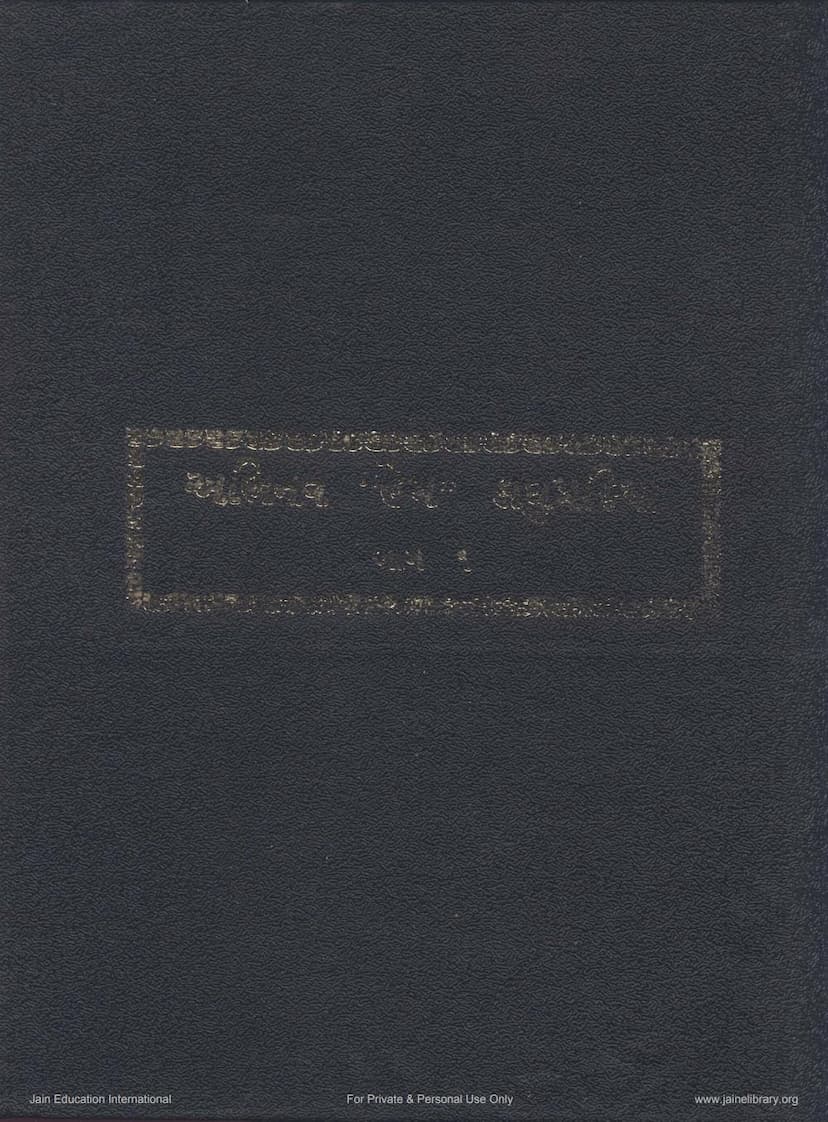Abhinav Hem Laghu Prakriya Part 01
Added to library: September 1, 2025

Summary
This Jain text, "Abhinav Hem Laghu Prakriya Part 01," authored by Dipratnasagar and published by Abhinav Shrut Prakashan, is the first part of a detailed commentary and translation of the "Hem Laghu Prakriya," a grammatical work attributed to Mahopadhyay Vinay Vijayji. The text is presented in Gujarati and aims to make the complex Siddh-Hem Shabd-Anushasan grammar, originally compiled by Hemchandracharya, accessible to Jain monks and nuns in their vernacular language.
Here's a breakdown of the content based on the provided pages:
Core Purpose and Philosophy:
- Accessibility: The primary goal is to provide a comprehensive understanding of Hemchandracharya's grammar in Gujarati, overcoming the difficulties faced by monks and nuns in accessing Sanskrit scholars and the cost associated with them.
- Bridging the Gap: It acknowledges the need for grammar study, which is considered foundational for understanding Jain scriptures. The text aims to demystify grammar and make it approachable.
- In-depth Knowledge: It goes beyond a simple translation, aiming to provide an exhaustive explanation by drawing from various reference texts like Brihad Vritti, Nyay Sangrah, etc., offering more than what is typically found in the "Laghu Prakriya" itself.
Key Features and Structure:
The book is meticulously structured to guide the reader through the intricacies of Sanskrit grammar, following the "Prakriya Kram" (process-based order) rather than the "Ashtadhyayi Kram" (chapter-based order) of the original Siddh-Hem.
- Preamble and Acknowledgements: The initial pages include salutations, acknowledgements to the inspirational guru (Pujya Muniraj Shri Sudharmasagarji Maharaj), and various scholars and Jains who contributed to the publication.
- Introduction to Grammar: It emphasizes the importance of studying grammar for linguistic purity, understanding scriptures, and ultimately achieving Moksha (liberation), quoting relevant verses.
- The "Abhinav Hem Laghu Prakriya": The title itself signifies an "Abhinav" (new/modern) approach to "Hem" (referencing Hemchandracharya's grammar) and "Laghu Prakriya" (a simplified grammatical process). The author clarifies that it's not just "two books" but a much more comprehensive work.
- Detailed Table of Contents (Anukramanika): The book features a detailed index, outlining the chapters which include:
- Mool Sutras (Original Sutras): The basic grammatical rules.
- Antargat Sutras (Internal Sutras): Rules that are part of larger concepts.
- Vishay Suchi (Subject Index):
- Sanjna (Technical Terms): Definitions of grammatical terms.
- Paribhasha (Grammatical Rules/Interpretations): Special rules and interpretations.
- Sandhi (Phonetic Changes):
- Swar Sandhi (Vowel Sandhi)
- Asandhi (Exceptions to Sandhi)
- Vyanjan Sandhi (Consonant Sandhi)
- Ref Sandhi (Sandhi related to 'r')
- Nouns (Gender-wise):
- Swarant Pulilng (Masculine nouns ending in vowels)
- Swarant Striling (Feminine nouns ending in vowels)
- Swarant Napunsakling (Neuter nouns ending in vowels)
- Vyanjanant Pulilng (Masculine nouns ending in consonants)
- Vyanjanant Striling (Feminine nouns ending in consonants)
- Vyanjanant Napunsakling (Neuter nouns ending in consonants)
- Pronouns:
- Yushmad (You)
- Asmad (I)
- Avyay (Indeclinables/Adverbs): Words that do not change form.
- Shuddhipatraka (Errata): A list of corrections.
- Parishisht (Appendix): Includes word-form lists, sutra sequence, alphabetical sutra index, and reference lists.
- Dravya Sahayaka (Material Assistance): Acknowledgement of financial supporters.
- Methodology:
- Sutra Analysis: Each sutra is presented with its "Sutra Pruthak-karan" (analysis of sutra components), followed by its "Vritti" (commentary) and "Vrutyarth" (meaning of the commentary).
- Anuvrutti (Continuation): Indicates which sutras are carried forward from previous ones.
- Vishesh (Special Notes): Explanations of specific points, grammatical nuances, and corrections or clarifications based on other authoritative texts.
- Examples: Numerous examples are provided to illustrate each grammatical rule.
- Footnotes: References to source texts and page numbers are given.
- Disambiguation of Misconceptions: The book specifically addresses and refutes the misconception that "Laghu Prakriya" is merely a two-book study, highlighting its extensive coverage of grammatical rules, roots (dhatus), and technical terms.
Content Highlights (Based on Chapters):
- Sanjna (Technical Terms): This extensive chapter defines essential grammatical terms like Swara (vowels), Vyanjan (consonants), Hastva (short), Deergha (long), Pluta (prolated), Guna, Vruddhi, Sanyoga (consonant cluster), etc., laying the groundwork for understanding the sutras. It also delves into the classification of letters based on their place and effort of articulation.
- Paribhasha (Grammatical Rules): This section clarifies important rules that govern the interpretation and application of sutras, such as rules concerning the fifth case (Panchami), seventh case (Saptami), sixth case (Shashthi), and how these cases influence grammatical operations. It also explains rules about the scope of sutras and exceptions.
- Sandhi (Phonetic Changes): This is a major part of the book, detailing the various rules for combining vowels (Swar Sandhi), consonants (Vyanjan Sandhi), and the modifications involving 'visarga' and 'ref' (which are often grouped under Sandhi). The text meticulously explains the rules, provides examples, and clarifies exceptions.
- Nouns (Subanta Prakarana): This is a substantial portion of the book, covering the declension of nouns. It categorizes nouns based on their endings (Swarant and Vyanjanant) and then systematically explains the formation of case endings (Vibhakti) for masculine, feminine, and neuter genders. This includes detailed examples and explanations for each case.
- Pronouns (Yushmad and Asmad): Special attention is given to the paradigms of "you" (Yushmad) and "I" (Asmad), showing their specific changes in different cases and numbers.
- Avyay (Indeclinables): This section explains words that do not change form according to gender, number, or case, providing a list and examples.
Overall Impression:
"Abhinav Hem Laghu Prakriya Part 01" appears to be a scholarly and practical work dedicated to making the foundational principles of Jain grammar accessible. The detailed explanations, numerous examples, and the systematic approach suggest it is intended for serious students of Jain grammar. The author's deep respect for his guru and the effort invested in this comprehensive work are evident.